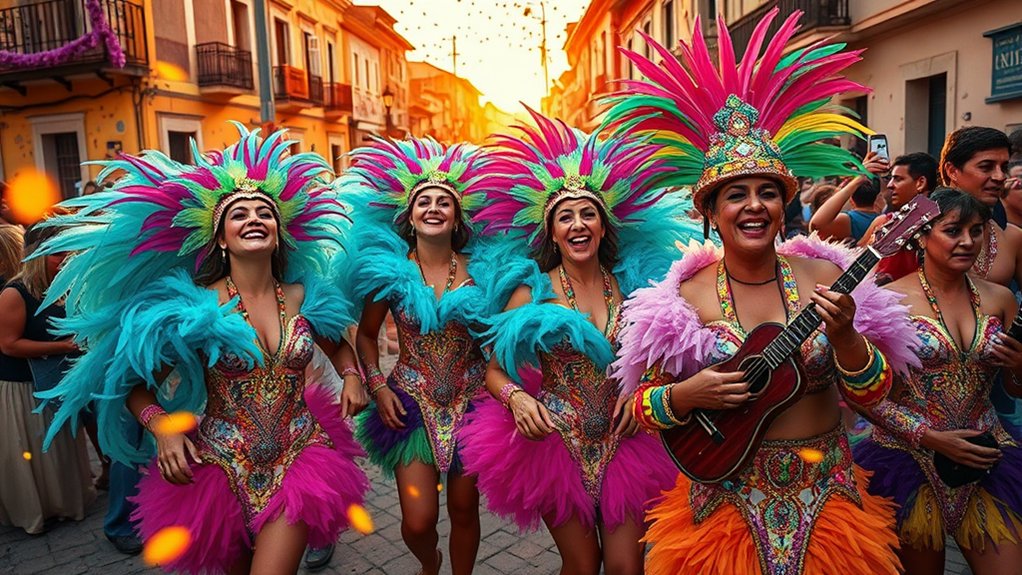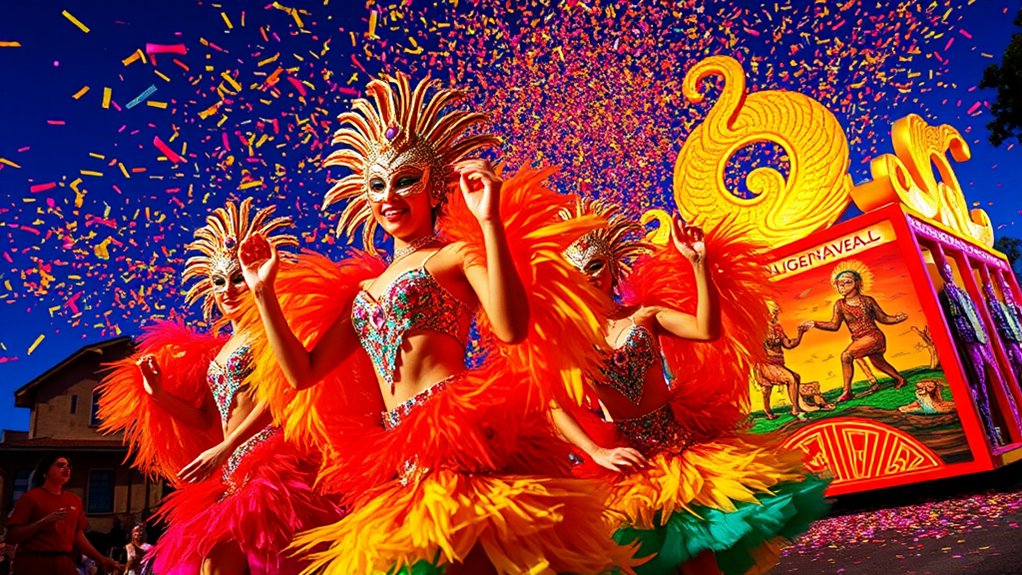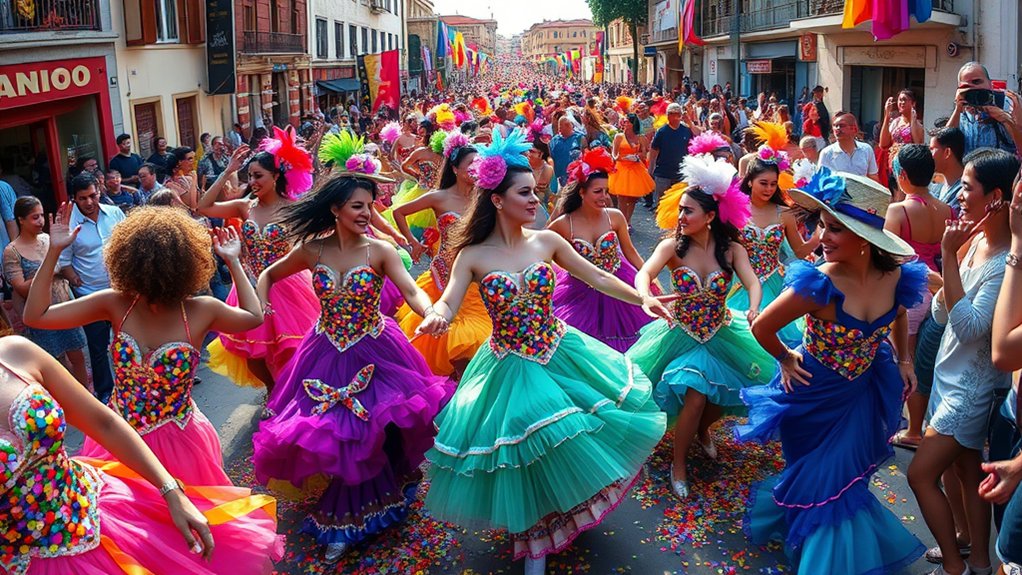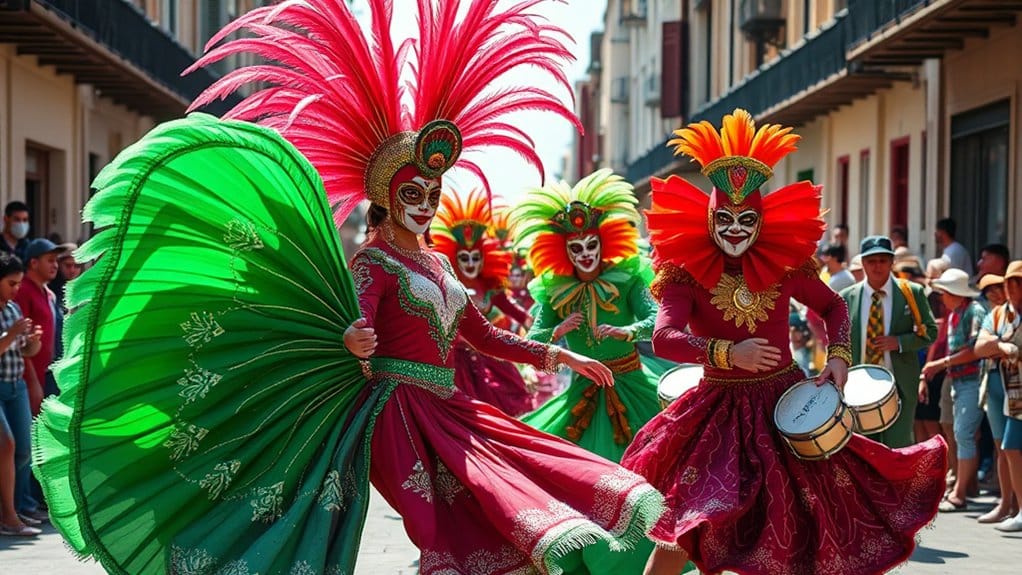Uruguay’s carnival, spanning 40 days, showcases African, European, and indigenous influences through music, dance, and costumes. Key events include the Inaugural Parade, Samba Schools Parade, and Desfile de Llamadas, featuring Candombe music and Murga dance. With preparations beginning in November, the carnival attracts over 7,000 attendees, highlighting its cultural significance. As a celebration of heritage, it preserves traditional music and dance forms, with various performances and competitions. Further exploration reveals the intricacies of this vibrant celebration, where cultural roots, history, and community come together in a unique, captivating experience.
Key Takeaways
- Carnival in Uruguay lasts approximately 40 days.
- It combines African and European cultural influences.
- Candombe music is a key part of the celebrations.
- Events include parades and competitions.
- Costumes reflect African and European heritage.
Carnival Duration and Timing

While Uruguay’s carnival is a highly anticipated event, its duration and timing are noteworthy, as the festivities last approximately 40 days, beginning in late January and continuing into early March. The carnival festivities, including parade schedules, are carefully planned, with key events like the Inaugural Parade, Samba Schools Parade, and Desfile de Llamadas. Parade schedules are packed, with multiple performances throughout the period, allowing attendees to enjoy the festivities freely, expressing themselves without constraints, and embracing the spirit of freedom that defines the carnival experience, with its vibrant atmosphere and exciting events. The preparation for the carnival starts in November, involving stages, decorations, and costumes, which showcases the cultural richness of the event.
Cultural Roots and History
Uruguay’s carnival has a rich cultural heritage, born from the fusion of various influences, including ancient European harvest festivals and Roman celebrations of Bacchus, as well as African traditions brought by enslaved individuals in the 18th century. The cultural evolution is evident in its historical significance. Key aspects include:
- African rhythms and dances
- European carnival traditions
- Christian celebrations
- Candombe music and dance, showcasing the blend of cultures, resulting in a unique cultural expression, symbolizing freedom and self-expression, highlighting the Determination of a nation to preserve its cultural roots. The carnival’s duration of approximately 40 days is a testament to the nation’s commitment to celebrating its collective history with vibrant parades and performances.
Festivities and Events

The festivities and events of Uruguay’s Carnival are a culmination of the country’s rich cultural heritage, featuring parades and performances that showcase its unique blend of traditions, including the Inaugural Parade, Samba Schools Parade, and Desfile de Llamadas. These events, which take place throughout January and February, are a reflection of the country’s determination to preserve its cultural roots, with parades and performances that highlight the Afro-Uruguayan influence, Candombe music, and dance. The carnival lasts for 40 days, featuring a strict pattern of parades that start with banner bearers and flag wavers. With a wide range of activities, including tablados, and performances on temporary stages across Montevideo, the Carnival in Uruguay is a vibrant celebration that draws large crowds, and offers an unforgettable experience, with ticket prices around $10, making it an accessible and family-friendly event.
Parades
Numerous vibrant parades take place during Uruguay’s carnival, showcasing a diverse array of artistic expressions and cultural heritage. Parade highlights, such as the Inaugural Parade, kick off the 40-day celebration, while parade traditions like the Desfile de Llamadas honor Afro-Uruguayan Candombe music.
- Inaugural Parade on January 23, 2025
- Samba Schools Parade on January 24, 2025
- Desfile de Llamadas on February 7-8, 2025
- Evaluations of comparsas by a jury, parade routes, and venues are key aspects of the events.
The celebration is known for its African influences, blending traditional rhythms with modern performances, thereby creating a unique experience for attendees.
Performances
Vibrant performances are a cornerstone of the carnival festivities, featuring an array of artistic expressions that showcase the country’s rich cultural heritage. Performance dynamics, including murga and samba, thrive through thematic analysis, allowing for satirical commentary on society. With costumes, makeup, and lyrical content, performers express themselves freely, showcasing the nation’s creative spirit. The events, held in various tablados, encourage community involvement, authentic experiences, and cultural exchange, highlighting the importance of performance dynamics and thematic analysis in Uruguayan carnival festivities, ultimately celebrating freedom of expression. The carnival’s duration, which can last up to 40 days, contributes to the extensive and diverse nature of these performances.
Music and Dance Forms
The vibrant music and dance forms of Uruguay’s carnival scene are characterized by distinctive rhythms, including Candombe Music, with its Afro-Uruguayan roots, Murga Dance, which combines theatrical and musical elements, and Samba Beats, influenced by Brazilian styles. These genres, each with its unique history and cultural significance, contribute to the rich fabric of Uruguay’s carnival celebrations, featuring a wide range of performances, from traditional drumming to elaborate costume displays. By examining these music and dance forms, including their origins, instruments, and performances, a deeper understanding of the cultural context and significance of carnival in Uruguay can be gained, highlighting the importance of preserving and promoting these integral parts of the country’s heritage. The celebration of Candombe is a significant event in Uruguay, where people gather to enjoy the African rhythms and dances that are an essential part of the country’s cultural identity.
Candombe Music
Candombe music, rooted in African tradition, emerged among young individuals of African slave descent in the late 18th century as a means of communication and connection through percussion, despite being forbidden by Uruguayan authorities. Characterized by the candombe rhythm, this music features distinct candombe instruments.
- Candombe is played with three types of drums
- The drums create a unique rhythm
- Candombe instruments are barrel-shaped
- The music fosters freedom and cultural heritage, expressing the community’s feelings, with the candombe rhythm defining the music, and the candombe instruments being essential to its creation.
The historical significance of candombe has contributed to its recognition as part of the Intangible Cultural Heritage, which is essential to the preservation of collective memory and cultural heritage.
Murga Dance
Many murga groups participate in Uruguay’s Carnival, showcasing their unique blend of music, dance, and satire. With a rich history, murga fusion has evolved, incorporating various choreography styles, reflecting the country’s cultural freedom. Performers, dressed in elaborate costumes, express themselves through energetic movements, and satirical commentary, criticizing social issues. The murga dance, a key element of Uruguayan Carnival, features polyphonic singing, percussion instruments, and recitative, creating a vibrant, expressive performance. Through their acts, murga groups convey messages of freedom, and social consciousness, making their performances a cornerstone of the Carnival celebration, and a proof of the country’s resilient spirit. Uruguayan murga performances typically feature up to 17 performers, usually men, and include percussionists playing a variety of instruments.
Samba Beats
Uruguay’s Carnival celebrations also feature samba beats, which bring a unique energy to the festivities. The samba influence is evident, with rhythmic variations that showcase the fusion of Brazilian samba with local rhythms.
- Samba schools play a key role
- Local rhythms are combined with samba
- Rehearsals start in December and January
- Parades feature handmade costumes and helmets. The result is a vibrant, freedom-filled celebration, determined to preserve cultural identity and showcase artistic expression, with a unique sound that sets Uruguay’s Carnival apart, driven by the beat of samba, with its Afro origins and unique rhythm. The event’s significant economic impact is due to its cultural tourism potential, attracting thousands of attendees and boosting local businesses.
Participation and Popularity

How extensively does the population engage with the Carnival in Uruguay, an event that captivates the nation for 40 days? Community involvement is high, with local traditions thriving. The carnival’s long duration of 40 days allows for more participants and spectators to engage in the festivities, enhancing its popularity and cultural significance.
| Aspect | Description | Participation |
|---|---|---|
| Attendance | High | 7,000+ |
| Practices | Year-round | 3,500+ |
| Cost | Affordable | $10 |
| Culture | Preserved | Historically rooted |
The carnival’s popularity stems from its affordability, family-oriented nature, and authentic experience, fostering a strong sense of community involvement and local traditions.
Carnival Categories and Groups
Because the Carnival in Uruguay is a multifaceted celebration, it encompasses various categories and groups that contribute to its vibrant atmosphere. The Murga evolution has played a significant role, with groups like Araca la Cana, Contrafarsa, and Falta y Resto. Lubolos significance is also notable, originating from colonial times. Key categories include:
- Murgas, with satirical themes
- Lubolos, involving face painting
- Parodistas and Humorists, with comedic performances
- Comparsas and Samba Schools, featuring Afro-Uruguayan roots. These groups come together, celebrating freedom and creativity, showcasing the rich cultural heritage of Uruguay’s Carnival.
The carnival’s historical context is deeply rooted in the tradition of Candombe, a folkloric dance that became central to street celebrations after the abolition of slavery, highlighting the importance of this event in Uruguayan culture.
Traditional Costumes and Characters

Traditional costumes and characters are an integral part of Uruguay’s Carnival, showcasing a unique blend of cultural influences and historical significance. Character significance is evident in costumes, reflecting the country’s African, European heritage. The costume evolution, rooted in candombe music, has led to distinctive characters like Mama Vieja, Gramillero. Vibrant outfits, face paint, beards, canes, and parasols are integral to these characters. These elements represent the freedom, cultural preservation, and social commentary that define Uruguayan Carnival, highlighting the importance of tradition, and creativity, in character significance, and costume evolution. The traditional drumming patterns of candombe are also key to the energetic performances of these characters during the Carnival celebrations.
Events and Competitions Overview
Uruguay’s Carnival is a vibrant showcase of events and competitions, featuring a diverse range of performances and activities that take place over several weeks, highlighting cultural significance and community involvement.
- Inaugural Parade
- Samba Schools Parade
- Tablados performances
- Competitions in five categories, the Carnival fosters freedom, self-expression, and creativity, with events showcasing the country’s rich heritage, and attracting large crowds, overall, it is a celebration of community, and cultural identity.




15 Responses
40 days of carnival? I can barely last 40 minutes without needing a snack!
‘Community involvement’? Count me in as long as there’s free food involved!
‘Parades filled with art and culture’ – what an awesome way to express community spirit! Love it!
The music and dance at Uruguay’s carnival must be amazing! I love how it brings people together!
‘Parades and competitions’—does that include who can eat the most churros?
I thought samba was just a fancy word for breakfast! Who knew it was a dance too?
Wow, this carnival sounds like so much fun! I can’t wait to see all the colorful costumes!
‘Murga dance’ sounds super fun! I can’t imagine how energetic those performances must be!
‘Traditional costumes’—does that mean I can wear my pajamas and call it cultural?
I really appreciate how this carnival celebrates different cultures. It’s so important to keep traditions alive!
The blend of African and European influences is fascinating! It’s great to learn about such rich cultural heritage.
Forty days of celebration? That sounds like a dream come true! I’m definitely going to check it out!
I love the idea of Candombe music being part of the celebrations. It must feel so vibrant and alive!
‘Cultural roots and history’ are so important, and it’s great that Uruguay showcases them through this carnival!
Candombe music sounds like the perfect soundtrack for my next dance-off with my cat!